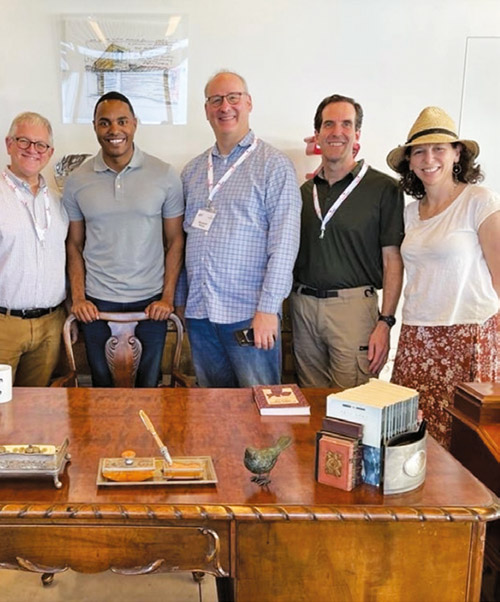
Last week, JCRC-NY’s Bronx Leadership Mission to Israel included Rabbi Binyamin Krauss, SAR principal; Rabbi Barry Dov Katz, Conservative Synagogue Adath Israel of Riverdale; Senior Rabbi Steven Exler, Hebrew Institute of Riverdale; Jessica Haller, executive director, New Majority NYC; Matt Abrams Gerber, chief operations officer, Riverdale Y; Bronx Borough President Vanessa Gibson; Bronx District Attorney Darcel Clark; and Rep. Ritchie Torres, whose new congressional district includes Riverdale.
Visiting the Israeli Innovation Center of the Peres Center for Peace and Innovation, Krauss noted, “What an inspiring place to better understand the depth and diversity of Israeli innovation. We met in Shimon Peres’ old office, redesigned as a ‘do’ tank as opposed to simply a ‘think’ tank. With innovation rooted in values of necessity, diversity and audacity, we can better understand Peres’ mission to apply the country’s innovation for good.” Such innovations include Waze and ICQ.
At south Tel Aviv’s Bialik-Rogozin School, delegates observed 1,150 students, mostly from low socio-economic families and a wide range of demographic groups, learning together. These local leaders toured the “mixed” city of Lod and its Lod Community Foundation, responsible for Lod’s physical development, as well as co-existence, bringing cultures together. The group also met Ashager Araro, 29, an Ethiopian woman born enroute to Israel during Operation Solomon. A long-time promoter of Ethiopian Jewish culture, she was designated one of Jewish News Syndicate’s top 40 global advocates for Israel.
On visiting an Iron Dome facility in Sderot, Kraus expressed, “It’s so powerful to visit this missile defense facility with a sitting member of Congress. The Iron Dome has intercepted thousands of missiles aimed at Israel, and is largely funded by the United States.”
Erel Margalit, head of Jerusalem Venture Partners (JVP), shared his track record bringing start-ups to Jerusalem and recently branching out to Kiryat Shemona (Israel’s food-tech center) up north and Beersheva down south. Margalit shared his social service “multiplier” Bakehila work improving children’s lives throughout the country.
The group, utilizing a Palestinian tour guide, also held meetings in eastern Jerusalem and Ramallah with Palestinian leadership. Krauss reflected, “This was my first direct exposure to restricted areas and Palestinian leadership, despite my many visits to Israel over the years. I especially wondered about the impression it was making on group members. Some were first-time Israel visitors.
In beautifully renovated Ramallah offices of the Palestinian Football Association, Krauss “was pleased to hear (a senior PA official) speak the language of peace, his commitment to non-violent resistance and a clear acceptance of the Jewish State of Israel. At the same time, as I read more about him online, heard from him about his time in Israeli prisons, and read his statements of recent years, as well as some of the terrorism he has been associated with in the past, I trembled at the thought of being in that room, and wondered whether I belonged in that place.” Krauss told him about terror victims he knew personally and tried to express the feelings of every Israeli who has lost a family member or friend to terror, and who spend much of their time in fear of it.
Later, they met with a Palestinian academic who partners with Israelis at Tel Aviv University, researching Israeli and Palestinian attitudes about peace, one-state and two-state solutions, religious commitment, political support for different parties, and many other fascinating topics. Krauss noted, “I was impressed with the wealth of information he shared with us, and hope to be able to study more of his work.”
The final day began at the Kotel with some members of the group going to Har HaBayit. Later, at Yad Vashem, Krauss noted, “Our guide encouraged us to focus on the ‘upstanders’ in society, and on the empowering but daunting understanding that people can choose unfathomable evil, and people can choose heroic good. Walking through this space together with colleagues and non-Jewish leadership, sharing the horrors, brought some measure of comfort and belief in the future, as the museum structure intentionally ends with natural light at the end of a narrow tunnel.”
The mission concluded with a group discussion of what the group members can take back to their respective work in the Bronx. Katz summarized, “I’ve never traveled to Israel with such a diverse group of leaders, each dedicated to a better world. I was moved by their vision for what the Bronx can be and their willingness to travel to Israel to learn how Israelis do this. I learned so much seeing Israel through the eyes of the other participants.”
Katz also noted, “The irony is that we needed to travel across the globe to meet. We live so close to one another. I look forward to sharing more of my love for Israel and Jewish tradition with the members of the group, hearing about the issues that are important to them, and increasing understanding in our borough.”
By Judy Berger













